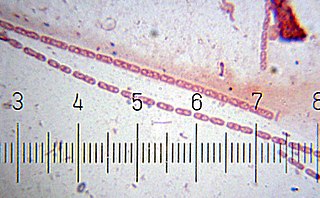
Streptobacillus is a genus of fastidious microaerophilic Gram-negative bacteria, which grow in culture as rods in chains.

The Nitrosomonadales are an order of the class Betaproteobacteria in the phylum Pseudomonadota. Like all members of their class, they are Gram-negative.
Members of the genus Selenomonas are referred to trivially as selenomonads. The genus Selenomonas constitutes a group of motile crescent-shaped bacteria and includes species living in the gastrointestinal tracts of animals, in particular the ruminants. A number of smaller forms discovered with the light microscope are now in culture but many, especially the large selenomonads are not, owing to their fastidious and incompletely known growth requirements.
Relapsing fever is a vector-borne disease caused by infection with certain bacteria in the genus Borrelia, which is transmitted through the bites of lice, soft-bodied ticks, or hard-bodied ticks.

Spirillum is a genus of Gram-negative bacteria in the family Spirillaceae of the Nitrosomonadales of the Betaproteobacteria. There are two species of Spirillum with validly or effectively published names - Spirillum winogradskyi and Spirillum volutans.
Spirillum minus is an organism associated with rat-bite fever that has never been fully identified and was assigned to the genus Spirillum in 1887 based on morphology, although it is not a validly published name. As Spirillum species generally obligately microaerophiles and are not found in mammals, this organism may be misclassified. Sequencing data should help to resolve this question.

Bacterial cellular morphologies are the shapes that are characteristic of various types of bacteria and often key to their identification. Their direct examination under a light microscope enables the classification of these bacteria.

Spirillaceae is a family in the order Nitrosomonadales in the class Betaproteobacteria of the bacteria.

Lesueurillidae is an extinct family of paleozoic molluscs (gastropods?) with anisostrophically coiled shells of uncertain position (Gastropoda?).

Bacterial taxonomy is subfield of taxonomy devoted to the classification of bacteria specimens into taxonomic ranks.
Cycloclasticus is a genus in the phylum Pseudomonadota (Bacteria).

Azospirillum brasilense is a very well studied, nitrogen-fixing (diazotroph), genetically tractable, Gram-negative, alpha-proteobacterium bacterium, first described in Brazil by the group of Johanna Döbereiner and then receiving the name "brasilense". A. brasilense is able to fix nitrogen in the presence of low oxygen levels, making it a microaerobic diazotroph. An isolate from the genus Azospirillum was isolated from nitrogen poor soils in the Netherlands in 1925, however the species A. brasilense was first described in 1978 in Brazil, since this genus is widely found in the rhizospheres of grasses around the world where it confers plant growth promotion. Whether growth promotion occurs through direct nitrogen flux from the bacteria to the plant or through hormone regulation is debated. The two most commonly studied strains are Sp7 and Sp245, both are Brazilian isolates isolated from Tropical grasses from Seropedica, Brazil.
Spirillum volutans is a gram-negative, bacterium from the genus of Spirillum which occurs in freshwater. It has an amphitrichous flagellar arrangement. Spirillum volutans is one of the largest bacteria species.
Thiorhodovibrio winogradskyi is a purple sulfur bacteria, the type species of its genus. Its cells are vibrioid-to spirilloid-shaped and motile by means of single polar flagella. It is moderately halophilic, with type strain SSP1.
Penicillium spirillum is an anamorph species of fungus in the genus Penicillium.

Aquaspirillum /ˌakwəspəˈrɪləm/ is a genus of helical aerobic bacteria in the family Neisseriaceae that lives in freshwater.
Azospirillum is a Gram-negative, microaerophilic, non-fermentative and nitrogen-fixing bacterial genus from the family of Rhodospirillaceae. Azospirillum bacteria can promote plant growth.
Mucispirillum is a genus in the phylum Deferribacterota (Bacteria). It is represented by the single species Mucispirillum schaedleri|. It has been found in the intestinal tract of some rodents and considered a commensal with some association to disease. This species has been found in cockroaches mice, turkeys, dogs, pigs, goats, termites, and sometimes humans. It is anaerobic and does not form spores. It is motile, flagellated and thought to have the ability to move through mucus.
Azospirillum lipoferum is a species of microaerophilic, gram-negative, rod-shaped, nitrogen-fixing bacteria. They are currently most notable for the ability to enhance the success of certain agricultural plant products such as maize, rice, and wheat.
Selenomonas sputigena is a species of anaerobe Gram-negative bacteria that is found in the upper respiratory tract of humans. It is the type species of the genus Selenomonas, with the type strain VPI D 19B-28. It is known to cause blood infection (sepsis), gum inflammation, and tooth decay. It alone cannot damage the tooth enamel, but worsen the damage done by other bacteria such as Streptococcus mutans,Porphyromonas gingivalis, Treponema denticola, and Tannerella forsythia.






